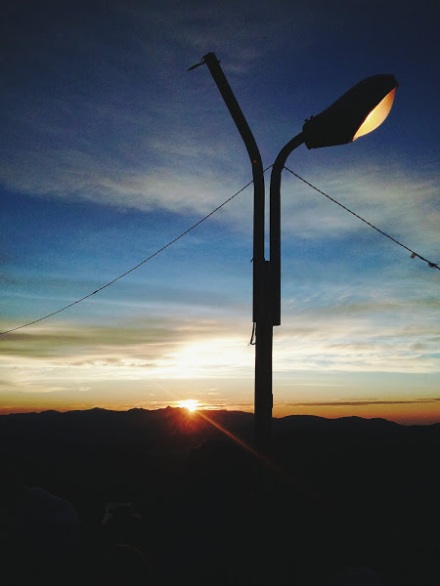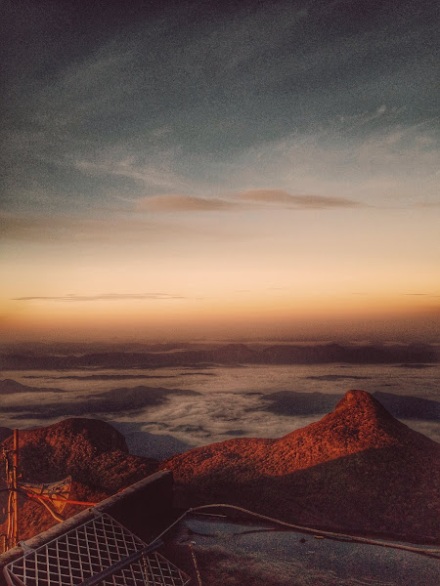Adams Peak can be a grueling trek but ultimately extremely rewarding. The cultural aspect especially, which makes it stand to reason to attempt it in the pilgrimage season. This was from last year. We trekked up half the distance through a jungle path* that only opens up when the villagers of Udamaliboda begin to use it for their own pilgrimage. The path is otherwise usually covered in thick undergrowth and you are likely to get lost if you attempt it at any other time. Also, even at the best of times, the risk of flash floods is real.
When you reach the steps proper, which in our case consisted of little more than rough cuts made into rock (the Kuruvita route. The more civilized paths lead up from Hatton and Ratnapura, the former is crowded and touristy, while the latter is longer but more peaceable and one with nature), and meet other pilgrims on their way up or down, they will greet you in verse invoking upon you the blessings of the god Saman, the deity of the mountain. You are generally expected to respond in kind, or bear the brunt of the uncomfortable silences that follow with respectful, sheepish smiles.
The mountain’s Sinhala name, Samanala, derives from the name of this god or also possibly the Sinhala word for butterfly, which is the same. The whole area surrounding the mountain, which is sacred and steeped in ancient lore and significance associated with all four major faiths the island hosts but primarily in the belief systems of the Sinhala people, is known as ‘the realm of the mountain god’ or ‘Samanala adaviya’, to those that revere it. It is also known as ‘Shri Pada’ (for the sacred footprint on its peak said to belong to Adam, Shiva or the Buddha based on which belief system you subscribe to) or Adam’s Peak.
There are four main paths that lead to the peak, and attribute it to what you will, but ascending or descending along the lesser populated ones, it is not hard to gather a sense of otherwordly profundity in every leaf that brushes your face, in the clumps of big rock roughly hewn to make way for human progress, in the breathtaking views and sights that greet you as you progress upwards or in every rivulet of icy water that crosses your path; from thin streams to the gushing majesty of the ‘seetha gangula’ or ‘cool river’ in which it is considered especially auspicious to bathe in.
In the case of the path we took, every leech that successfully latched on to our foot in tenacious determination, sucking our blood and giving us the itches for weeks afterwards, also succeeded in conveying something otherworldly, just not so much in a good way. But if you are up for a tough hike, I would strongly recommend the path from Udamaliboda. In an age of ease and convenience, it alone remains one of the only truly ‘authentic’ ways up there. I know, I sound like such a hipster.
Remarkable people come to the peak. I saw old men and women, some supporting themselves with walking sticks resolutely making their way upwards, even passing us, our poor touristy tread unfired by any sense of profound purpose, in an amazing testament to the power of human faith. Whole families, nay, whole villages will come up the mountain together, many will carry toddlers all the way up and all the way back down. They will bring supplies and cook and sleep and live their way up the mountain, often taking days to complete the pilgrimage, taking advantage of the many ‘ambalamas’ or resting places constructed for the purpose.
It is said that Ibn Batuta, the famous Moroccan Islamic jurist who pretty much made an envious lifelong career out of traveling and writing about it, talked the Tamil king of the North at the time into taking him to the peak. He must have gone through thick jungle, forbidding trials, and territory belonging to Sinhalese kings, but he doesn’t appear to have experienced any untoward problems. In Islamic tradition, including the prophet’s (may peace be upon him) hadeeth, there is some evidence that Adam could have alighted upon Sarandib, but there is evidence just as strong that makes the case of him having landed in Jordan. Anyhow, it appears that Muslim traders initially made a big deal of the former, which also resulted in increased access to the hinterlands, and expansion of the trade in gems, both a spiritually and commercially profitable enterprise.
The multiculturalism of Adam’s peak however, I can attest to. When I found myself up there before sunrise, I was anxious to offer my pre-dawn salah. This was at the height of BBS induced anti-Muslim hate in the country, and being the city slicker I am, I naively feared I would be mobbed in mid-prayer. The top of the mountain is a warren of construction; temples and viewing platforms; sprawling resting places, all squeezed into a very small piece of land right on the peak, which incidentally results in terrible foot traffic jams along the more crowded Hatton route, which sort of beats the purpose of taking the shorter, more commercial path to the top.
I apprehensively laid my prayer rug amidst sleeping bodies, in what I thought was a secluded corner. And proceeded to pray. I kept hearing hubbub in the background, hubbub which I expected to rise to a crescendo of outrage at any moment. But nothing happened. I prayed, nodded at a few groggy people just waking up, and left. I felt unnoticed, unremarked upon, and more than anything else that could have happened, that made me feel welcome, a part of the crowd.
Nothing really left to talk about except for the sunrise, which everyone waits for, and which is pretty much the point of the whole exercise for those that aren’t religiously motivated. There is a very long moment of staring into the East, hundreds of people literally looking towards the East, faces open and expectant as if hoping for some sort of divine revelation. And the sun is a total tease. It made us wait and wait, and finally deigned to let loose a single gleam, a ray as sharp as a laser beam piercing through the crowd, before finally rising completely to the occasion.
The sun will soon be too bright to look at, but if you glance off the Western side of the mountain, you will see the massive triangular shadow of the peak stretching to the horizon, the mist still caught in the valleys of lesser peaks look like trapped lakes. It is truly a breathtaking sight.
*information on trails and travel advice to Adam’s Peak can be found on the excellent Lakdasun





![Quran[1]](https://abdulhalik.wordpress.com/wp-content/uploads/2010/01/quran1.jpg?w=545)
